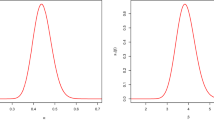Abstract
In many clinical studies, there are two dependent event times with one of the events being terminal, such as death, and the other being nonfatal, such as myocardial infarction or cancer relapse. Morbidity can be dependently censored by mortality, but not vice versa. Asymptotic theory is developed for simultaneous estimation of the marginal distribution functions in this semi-competing risks setting. We specify the joint distribution of the event times in the upper wedge, where the nonfatal event happens before the terminal event, with the popular gamma frailty model. The estimators are based on an adaptation of the self-consistency principle. To study their properties, we employ a modification of the functional delta-method applied to Z-estimators. This approach to weak convergence leads naturally to asymptotic validity of both the nonparametric and multiplier bootstraps, facilitating inference in spite of the complexity of the limiting distribution.
Similar content being viewed by others
References
Clayton, D. G. (1978). A model for association in bivariate life tables and its application in epidemiological studies of familial tendency in chronic disease incidence, Biometrika, 65, 141–151.
Copelan, E. A., Biggs, J. C., Thompson, J. M., Crilley, P., Szer, J., Klein, J. P., Kapoor, N., Avalos, B. R., Cunningham, I., Atkinson, K., Kowns, K., Harmon, G. S., Daly, M. B., Brodsky, I., Bulova, S. K. and Tutschka, P. J. (1991). Treatment for acute myelocytic leukemia with allogenic bone marrow transplantation following preparation with Bu/Cy, Blood, 78, 838–843.
Day, R., Bryant, J. and Lefkopoulou, M. (1997). Adaptation of bivariate frailty models for prediction, with application to biological markers as prognostic factors, Biometrika, 84, 45–56.
Efron, B. (1967). The two sample problem with censored data, Proc. Fifth Berkeley Symp. on Math. Statist. Prob., 4, 831–855, Univ. of California Press, Berkeley.
Efron, B. (1979). Bootstrap methods: Another look at the jackknife, Ann. Statist., 7, 1–26.
Hall, P. (1992). The Bootstrap and Edgeworth Expansion, Springer, New York.
Jiang, H., Fine, J. P. and Chappell, R. J. (1999). Estimation of the association between bivariate failure times in the semi-competing risks problem, 1999 Proceedings of the Biometrics Section, 192–194, American Statistical Association Alexandria, Virginia.
Jiang, H., Fine, J. P., Kosorok, M. R., and Chappell, R. J. (2001). On self-consistency in the gamma frailty model with dependent censoring. Tech. Report, No. 137, Department of Biostatistics and Medical Informatics, University of Wisconsin, Madison.
Klein, J. P. and Moeschberger, M. L. (1997). Survival Analysis: Techniques for Censored and Truncated Data, Springer, New York.
Murphy, S. A. (1994). Consistency in a proportional hazards model incorporating a random effect, Ann. Statist., 22, 712–731.
Murphy, S. A. (1995). Asymptotic theory for the frailty model, Ann. Statist., 23, 182–198.
Oakes, D. (1986). Semiparametric inference in a model for association in bivariate survival data, Biometrika, 73, 353–361.
Oakes, D. (1989). Bivariate survival models induced by frailties, J. Amer. Statist. Assoc., 84, 487–493.
Parner, E. (1998). Asymptotic theory for the correlated gamma-frailty model, Ann. Statist., 26, 183–214.
Praestegaard, J. and Wellner, J. A. (1993). Exchangeably weighted bootstraps of the general empirical process, Ann. Probab., 21, 2053–2086.
Robertson, J. B. and Uppuluri, V. R. (1984). A generalized Kaplan-Meier estimator, Ann. Statist., 12, 366–371.
Serfling, R. J. (1980). Approximation Theorems of Mathematical Statistics, Wiley, New York.
Tsai, W.-Y. and Crowley, J. (1985). A large sample study of generalized maximum likelihood estimators from incomplete data via self-consistency, Ann. Statist., 13, 1317–1334.
Tsiatis, A. A. (1975). A nonidentifiability aspect of the problem of competing risks, Proc. Nat. Acad. Sci. U.S.A., 72, 20–22.
van der Vaart, A. W. and Wellner, J. A. (1996). Weak Convergence and Empirical Processes, Springer, New York.
Vardi, Y. and Zhang, C.-H. (1992). Large sample study of empirical distributions in random multiplicative censoring model, Ann. Statist., 20, 1022–1039.
Author information
Authors and Affiliations
About this article
Cite this article
Kosorok, M.R., Fine, J.P., Jiang, H. et al. Asymptotic Theory for the Gamma Frailty Model with Dependent Censoring. Annals of the Institute of Statistical Mathematics 54, 476–499 (2002). https://doi.org/10.1023/A:1022450708498
Issue Date:
DOI: https://doi.org/10.1023/A:1022450708498




